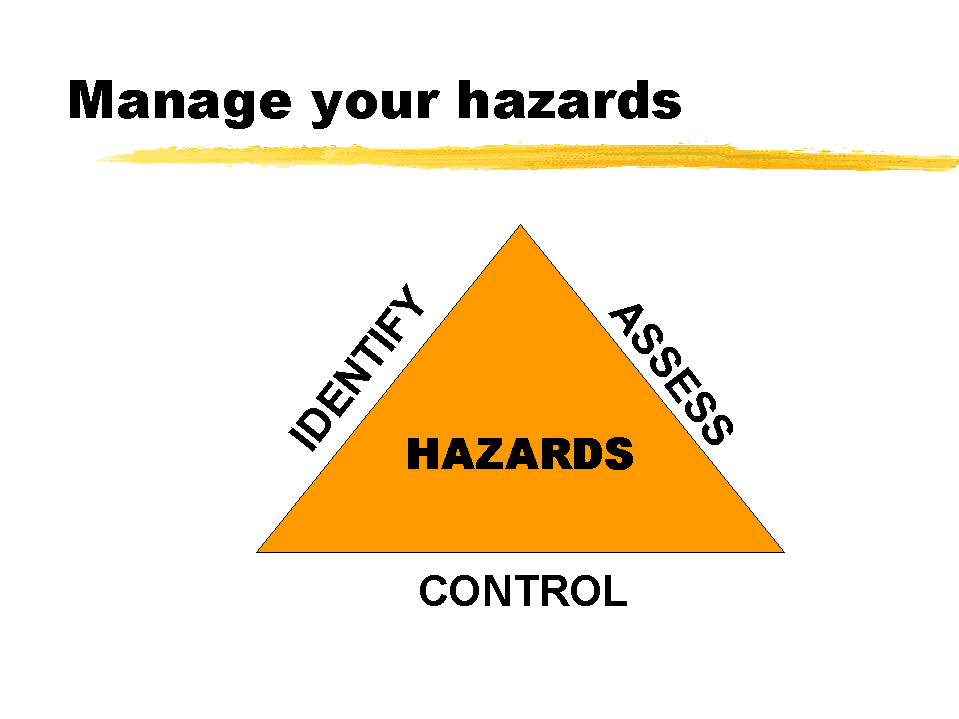

A HAZARD is any plant, substance or situation likely to cause injury, illness or incident should it become uncontrolled.
HAZARDS surround us in varying forms and degree of risk. A Risk Management programme must take into account all hazards likely to affect, or be affected by, the tasks associated with the job. This includes anticipating outcomes from the completed job (eg a power point may be incorrectly installed by an electrician, resulting in an injury occurring to a future user).
IDENTIFY hazards in your work area by making regular inspections of the site; use all your senses - including intuition - to ascertain whether you are in a safe situation. Your nose may be the first indicator of a leaking hazardous substance or smoke from a fire; your ears may pick-up the obvious potential of noise being too loud, or the less-obvious sounds of an overstressed motor bearing. The sense of touch can discern a moist surface where perhaps moisture is not meant to be; taste can detect the feint hint of tainted food, and so on. Consider annual 'desk-top' reviews of 'work method statements' (WMS). A WMS will outline step-by-step procedures for carrying out a task. Each step can be considered in isolation and any hazards identified. Manual handling, hazardous machinery and hazardous substances in particular can be revealed in studying a WMS. Investigate and review all incident reports.
ASSESS the risk associated with a hazard by considering three aspects: the likelihood of the hazard becoming uncontrolled; the degree of injury/illness/damage should it become uncontrolled; the frequency of interaction with the hazard.
CONTROL of the hazard is what our safety programme is all about. Ideally, we should ELIMINATE the need for the hazard altogether, but if we can't, we might be able to SUBSTITUTE a safer hazard instead, and so on down the hierarchy. Sometimes, a combination of the steps will apply. EG Personal Protective Equipment (step 5) might still be worn in step 2 (Substitute), and so on.
Steps and examples in the hierarchy are:
1 ELIMINATE -
Can the hazard be left out of the equation altogether? In the planning stage, ask if there is any need to use or have the hazard around. An example might be (say) a vacuum cleaner that is going to be used in a high-traffic area. You know the electric lead to it is going to create a trip hazard, so the need for a lead is eliminated by using a battery powered cleaner.
2 SUBSTITUTE -
There is a need to paint some stage materials, and the plan has been to use some epoxy paint that happens to emit toxic fumes. Is there a water-based, less-toxic paint available that will do the job?
3 ISOLATE/VENTILATE -
Perhaps a noisy drive motor for some gadget or other is able to be isolated by being placed in a less-frequented part of the building, or a sound-proofed cage built around it. Unpleasant smells, contaminated or stale air might be ventilated from an area by use of an exhaust fan.
4 MITIGATE -
If there are no other options, perhaps the only way around the problem is to rotate staff who have to work with the hazard, ensuring they are only in contact with the hazard for limited amounts of time. EG Keyboard entry; exposure to heat and cold, and so on.
Training also falls into this area of hazard control, and includes appropriate methods of operating plant or 'how to install…' and so on.
5 PERSONAL PROTECTIVE EQUIPMENT (PPE) -
PPE is always the 'last resort' of control. Don't forget, this usually means there is nothing between the hazard and ourselves other than a layer of protective clothing or a mask or glasses. If this layer breaks down, then there is nothing between ourselves and the hazardous situation.
EG Protective gloves to handle chemical cleaning agent.
Note that steps 1,2 and 3 above are ENGINEERING CONTROLS and generally remove the opportunity of human failings to step into a hazardous situation. (EG a machine guard will protect the smartest and the dumbest persons. The old miners' saying, "You are only as safe as the stupidest man in the mine..." may well be recalled here.) Steps 5 and 6 are ADMINISTRATIVE CONTROLS and can breakdown when weaknesses in human behaviour occur. (EG I might forget to take a break from a particularly debilitating task, or from a proximity to a hazardous substance; I might forget to put on a piece of essential personal protective equipment.)
Welcome Page | About Us | Services | Pricing | Book of Triangles | Contact Us | Other Safety Sites